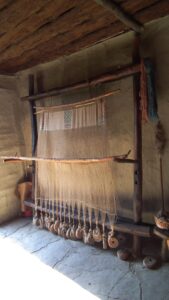Warp Weighted Looms
Cathy Koos
As I perch before my Harrisville floor loom, I often admire its lovely wood and how well constructed it is, with various pegs and bolts and levers, mechanics well thought out and engineered. Not so for our earlier weavers of ancient times.
Very early looms allowed the weaver to be seated, with the loom frame pegged out on the ground. This was adequate for temperate climates, but the further north the weaver, the more inconvenient. Sometime during the Bronze Age, a weaver got the idea to bring the loom inside. Perhaps she had a big project on the loom and bad weather was coming. Regardless the motivation, if a weaver wanted large pieces of cloth, weaving on big looms moved inside.

Figure 1Liz Mann, Ancienttool.net
Moving a loom inside had its consequences—natural light was suddenly reduced to only an open door or window. However, that was more than made up by the weaver’s ability to weaver day or night, good weather or inclement.
The loom required two solid upright posts and two deep post holes sturdy enough to resist the continual beating of the sword. Several cross posts were also employed for the beam, heddle rod and shed rod.
By leaning the upright posts against the wall, both a space was created behind the work, as well as a space to hang the all-important loom weights. Sometimes no other evidence is left behind in an ancient dwelling except for the loom post holes and a pile of clay or stone loom weights.

Figure 2 Liz Mann, Ancienttools.net
According to Liz Pearson Mann of gohomespun.com, “Loom weights survive in the murky depths of lakes in Switzerland, scattered around the waterlogged remains of collapsed lakeside villages. We have found from archaeological excavation that these are the settlements of the earliest farmers in the region. These are Neolithic farmers, or new stone-age farmers. Because of their existence, we know that the warp-weighted loom has been around for even longer than the weavers depicted on Bronze Age Grecian vases. Since 3000 years BC or more people have been stringing up their looms, weighting threads with loom weights.
Fragments of linen cloth have been dredged up from the Swiss lake silts, soggy and dark brown, but revealing quite complex weaving techniques. We’ve been that clever for that long.”